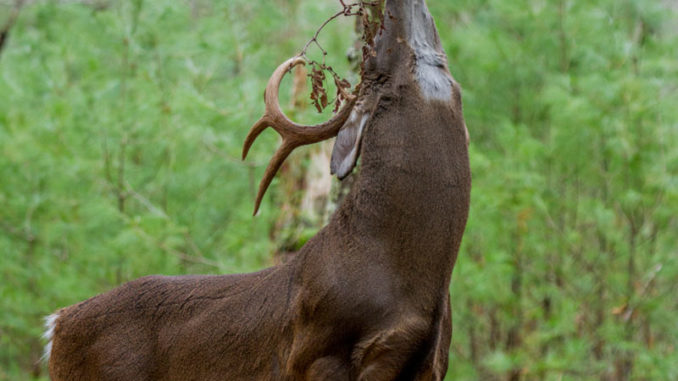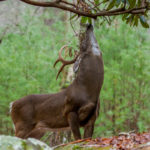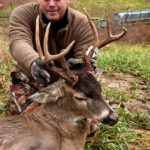
A deer’s sense of smell is its first line of defense, but it can be breached with some care on the part of a hunter.
With the rut still well in the future, deer hunters must find a way to stay under the radar from all of a buck’s senses if they want to look up and find their target within shooting range.
Out of the five basic senses hunters must conceal from deer, olfaction, aka the sense of smell, is a major asset to a whitetail’s survival. Hunters can get one step closer to bagging their trophy if they can maneuver around the deer’s most-expert sense and remain undetected in the woodlot.
Compared to humans, deer have a real superhero ability when it comes to detecting odors from long distances, and it is definitely physiological. In the deer’s brain, a very large area is dedicated to olfactory sensory capabilities. Deer are thought to detect odors over a thousand times better than humans, although no true scientific studies exist to back up this claim. If their advanced scent-detection ability was compromised in any way, deer would quickly make their way to the endangered species list.
From cover scents made from skunk and fox urine to estrous urine blends developed to pull bucks in from afar, there are literally hundreds of scent products available today to the hunter. But do they work? For most hunters, the effectiveness of specific scent products is extremely variable.
Robert Johnson of Cherryville, an American Whitetail Authority pro hunter, spends tons of time every year chasing down stout-racked bucks in multiple states. For Johnson, a deer’s ability to detect odors is his ultimate hurdle to pulling a mature whitetail into range, especially during archery season, which opens Sept. 12 across North Carolina.
“Deer can smell you where you are at and where you have been under most circumstances,” he said. “Out of my 30 years of hunting, I used estrous scents religiously for the first 15 years and never had any positive successes while using them.”
No doubt, deer excrete and deposit odors from their scent glands on tree branches, saplings and the ground. Whether they are urinating on their tarsal glands or directly depositing secretions from their many scent-producing glands, they are, in fact, laying down a scent message for deer of both genders to interpret. But when collected and bottled, the message may not be coming across the right way or at all. Or maybe it is something deeper than a scent detected from the olfactory sensual center?
Deer also have a unique sense related to the olfactory region of the brain that is disparate or vestigial to humans. Reptiles, deer and other mammals are equipped with a vomeronasal organ nestled in the mouth cavity. This unique organ provides deer with a remarkable ability to detect pheromones along marked territories, scent stations and animal corridors. The characteristic “lip curl” observed in bucks during the rut illustrates this organ in action. When rutting bucks detect urine in the air, they flair out their lips and put their vomeronasal organ to work. Deer can easily determine if the doe that left the signs is in estrus or approaching from detecting sex pheromones. But pheromones are thought to dissipate quickly, leaving just a dribble of urine.
Estrous scents have been ineffective for Johnson, who attributes his lack of success to the absence of active pheromones available. However, he still believes that scent manipulation is one of his most-powerful tactics that can be used to get closer to a trophy buck.
“I have used skunk, raccoon and fox cover scents, and the deer will still smell you if you are downwind of them. From my 30 years of experience, concealing your own scent is most important,” he said.
Deer and other animals learn from association. Deer understand human odors and other odors from the human environment are potential dangers, especially the mature animals that have had many close calls when human scent was detected. When hunters contaminate their hunting stands or hunting areas with human odors, deer are quickly alarmed and will find another route, leaving hunters empty handed.
Every time Johnson sets up a new stand, he makes sure the site is in an area where the prevailing wind will push his scent away from the direction he believes the deer will approach.
“When scouting a new area, I will pull up the wind history for that location from (the National Oceanographic and Atmospheric Administration) and set up my stands with relation to the most-common wind direction for that spot and time period. We never hunt these stands when the wind is not coming out of the preferred direction,” he said.
Beyond setting up his stands, Johnson makes every effort to reduce his scent footprint while visiting stands and during his hunts. From carbon clothing to unscented detergents and unscented bath gel, reducing scent contamination is something Johnson believes in, and one product is critical gear for Johnson.
“I am a firm believer is Scent-A-Way made by Hunter’s Specialties in Iowa,” he said. “Anytime I touch anything, including the ladder rungs on climbing sticks, tree stands, deer decoys and anything else for that matter, (it) gets a dousing. I am not sure what it is made of, but it positively helps reduce my footprint around my stand sites.”
Johnson always wears a clean pair of gloves to make sure his honey holes aren’t tainted.
“If you touch parts of your stand bare-handed, the scent will stay on there for at least three days, and the deer will start avoiding it. In one of my deer clubs, using gloves is a strict rule,” he said.
While some smaller, immature deer will ignore the human scent left on the tree stand, the mature bucks most hunters are in search of will instantly identify the danger and travel a different way next time.
Deer live and die by their noses. From finding mates, food, and sensing dangers, the big black organ on the end of a deer’s snout is their primary weapon of protection. If hunters want to get a chance at bagging a mature buck during the rut or any other time of the season, scent control and elimination tactics are required tools of this trade.






Be the first to comment